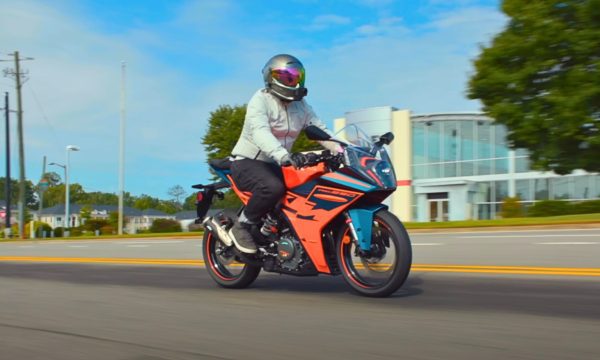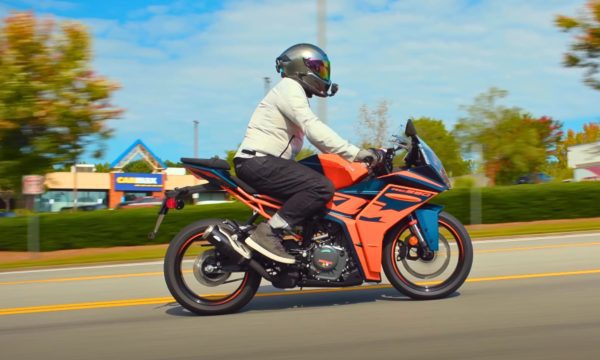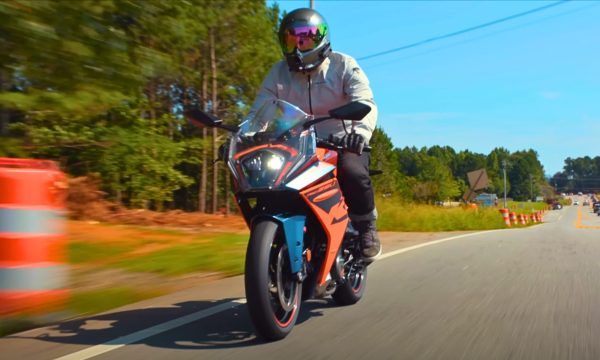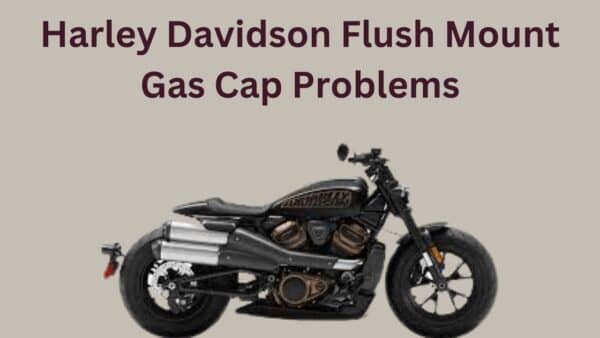The KTM RC 390 is a popular choice among motorcycle enthusiasts, known for its agility and power. However, like any vehicle, it’s not without its issues.

So, in this article, we’ll discover the most common problems that KTM RC 390 owners are facing and provide you with solutions.
Whether you’re a current owner or considering purchasing one, understanding these challenges can help you make informed decisions.
Let’s dive in!
KTM RC 390 Problems
KTM RC 390 common problems are radiator fan issues, head gasket, electrical gremlins, stator problems, oil management, suspension upgrades, quick shifter, clutch and low RPM stalling, gear shift lever issues, and kickstand sensor problems.

1. Radiator Fan Issues
One common problem with the KTM RC 390 is related to its radiator fan. This issue often involves the fan not kicking in when the engine temperature reaches a certain level, leading to overheating.
This can be a result of a faulty fan motor or a malfunctioning thermal switch. A DIY fix is to check the fuse associated with the fan circuit for any signs of damage and replace it if necessary.
Another step is to clean the fan’s blades and ensure no obstructions are blocking its movement.
If these simple checks don’t resolve the problem, it might be the thermal switch that needs a look.
You can test its function by momentarily bypassing it to see if the fan turns on. If it does, replacing the thermal switch should fix the issue.
2. Head Gasket Problems
The head gasket is a critical seal within the engine of the RC 390, playing a vital role in maintaining the correct pressure and ensuring the engine’s coolant and oil do not mix.
When it fails, it can lead to overheating, loss of power, and potentially severe engine damage.
Common signs of a failing head gasket include white smoke from the exhaust, an overheated engine, or a visible oil and coolant mixture.
To address this issue, you should replace the gasket. This involves disassembling the top part of the engine, which requires specific tools and knowledge.
On the other hand, regular maintenance and keeping an eye on the engine’s temperature can help prevent such problems.
3. Electrical Gremlins
The electric gremlins can range from flickering dashboard lights to the motorcycle’s inability to start.
The root cause is frequently linked to loose or corroded electrical connections and fuses.
To resolve this, you should regularly check and clean all electrical connectors, especially those exposed to the elements.
You can also apply a layer of dielectric grease to protect against corrosion.
Also, ensure the battery terminals are tight and corrosion-free, as a weak battery connection can lead to several electrical problems.
For fuses, inspect them for damage and replace any that are blown.
4. Stator Problems
When the stator malfunctions, you might notice your motorcycle’s battery draining faster than usual, leading to difficulties in starting the bike or causing the electrical systems to fail during a ride.
To resolve the problems, you should identify signs of failure, which can include a dead battery, dim lights, or the engine running poorly.
Next, ensure that the battery is in good condition and properly charged, as a faulty battery can sometimes mimic stator issues.
If the battery is fine, inspect the stator’s connections for any loose wires or corrosion that might be interrupting the flow of electricity.
If the problem persists, the stator may be damaged or worn. So, you’ll need to examine the stator’s coils for any signs of burning, cracking, or insulation wear.
5. Oil Management
Another issue riders encounter is managing the oil levels and understanding when to replace the oil.
This motorcycle demands high-quality oil for optimal performance, but sometimes, riders might not notice the signs of oil degradation.
The symptoms of poor oil management are a noticeable decrease in engine smoothness, increased engine noise, and a reduction in performance.
To resolve this, you should regularly check oil levels and the color of the oil through the inspection window.
If the oil appears dark and dirty rather than a clear amber color, it’s time for a change. While replacing the oil opt for a high-grade oil.
Moreover, adhere to the recommended service intervals for oil changes to ensure the longevity and reliability of the bike.
6. Suspension Upgrades
The stock suspension can sometimes feel too rigid for daily commuting, leading to a less comfortable ride over bumps and uneven roads.
So, you should consider upgrading to a higher-quality suspension system that can significantly enhance the motorcycle’s shock absorption capabilities.
This can be particularly beneficial for those who use their bike both in urban settings and on longer rides.
Moreover, improved suspension can help in better handling, giving riders more confidence during turns and at higher speeds.
So, you should look for a balanced upgrade for aftermarket shock absorbers and adjustable front forks.
7. Quickshifter/Autoblipper
The quick-shifter feature allows riders to shift gears more quickly without needing to use the clutch or throttle manually.
However, some users have reported problems with this feature, such as it not working as smoothly as expected, especially when downshifting, or not working at all.
A simple solution to this issue can often be found in adjusting the settings of the quick shifter through the motorcycle’s onboard computer system.
Also, you should ensure the bike’s software is updated which can resolve many of these glitches.
8. Clutch and Low RPM Stalling
This problem often stems from a too-lean fuel-air mixture at idle or a clutch that is improperly adjusted.
To resolve this, you should try adjusting the idle RPM speed to a slightly higher setting, and ensure the engine doesn’t stall when power demand is low.
You should also adjust the clutch play according to the user manual to ensure smoother engagement and prevent the motorcycle from stalling.
These adjustments can often be made with simple tools and a bit of patience, improving the riding experience significantly.
9. Gear Shift Lever Issues
This often happens because the shift lever is either too tight, not properly aligned, or there’s an issue with internal components like the shift fork or gears.
To resolve this, you should first try adjusting the position of the shift lever. Sometimes, it’s just not in the right spot for your foot.
If that doesn’t help, you should inspect the lever for any visible damage or excessive wear is a good step.
Over time, parts wear down, and something as simple as replacing a worn-out lever can make a big difference.
Another do-it-yourself fix involves the clutch adjustment. Incorrect clutch cable tension can also make gear changes hard.
You should ensure it’s correctly adjusted according to the bike’s manual and can resolve shifting issues.
10. Kickstand Sensor Problems
A common cause for kickstand sensor issues is dirt or debris interfering with the sensor’s ability to detect the position of the kickstand properly.
Another possibility is a loose or damaged connection where the sensor connects to the bike’s electrical system.
To fix this problem, first, try cleaning around the kickstand and sensor area thoroughly to remove any dirt or grime.
If the problem persists, you should check the sensor’s wiring for any signs of damage or looseness.
If you find loose connections ensure tightening them or replacing damaged parts may resolve the issue.
Is KTM RC 390 reliable?
The KTM RC 390 is recognized for its reliability and performance, especially among entry-level sports bikes.

It is equipped with a powerful engine and advanced features that make it a favorite among riders looking for speed and agility.
However, like any vehicle, its reliability can depend on how well it is maintained and cared for.
KTM RC 390 User Review
The KTM RC 390 has impressed riders with its performance upgrades like better suspension and brakes, but some users faced issues like blown head gaskets and electrical problems.
Despite these challenges, the bike has changed perceptions of small bikes with its aggressive design and speed. To tackle the reliability issues, KTM needs to document complaints and encourage repairs at authorized dealers for future improvements.
KTM RC 390 Technical Specifications
| Specification | Detail |
| Make Model | KTM RC 390 |
| Year | 2022 |
| Engine | Four stroke, single cylinder, DOHC, 4 valves |
| Capacity | 373 cc / 22.7 cu-in |
| Bore x Stroke | 89 x 60 mm |
| Cooling System | Liquid Cooled |
| Compression Ratio | Not specified |
| Induction | Bosch Injection |
| Emission | EURO5 |
| Lubrication | Wet sump |
| EMS | Bosch EMS with RBW |
| Starting | Electric |
| Max Power | 32 kW / 43 hp @ 9500 rpm |
| Max Torque | 37 Nm / 27.2 lb-ft |
| Clutch | PASC antihopping clutch, mechanically operated |
| Transmission | 6 Speed |
| Final Drive | 520 X-Ring |
| Frame | Steel trellis frame, powder coated |
| Front Suspension | USD WP APEX 43 |
| Front Wheel Travel | 120 mm / 4.7 in |
| Rear Suspension | WP APEX – Monoshock |
| Rear Wheel Travel | 150 mm / 5.9 in |
| Front Brakes | Single 320 mm disc 4 piston radial fixed calliper |
| Rear Brakes | Single 230 mm disc 1 piston floating calliper |
| ABS | Bosch 9.1MP Two Channel ABS (Supermoto ABS) |
| Front Tyre | 110/70 R17 |
| Rear Tyre | 150/60 R17 |
| Seat Height | 824 mm / 32.4 in |
| Dry Weight | 155 kg / 341.7 lbs |
| Fuel Capacity | 13.7 Liters / 3.6 US gal |

Ahtsham Younas is a passionate blogger and content writer. He loves to ride motorcycles and learn the mechanical process behind the motorcycles.
He has been writing articles in the motorcycle industry since 2019 and has learned many things about motorbike niches.


